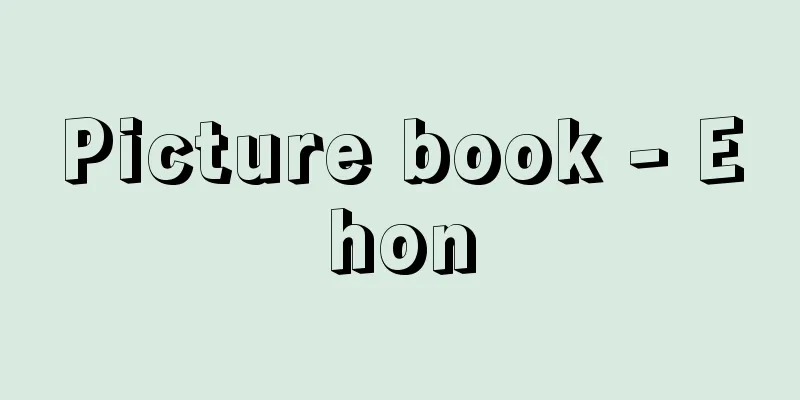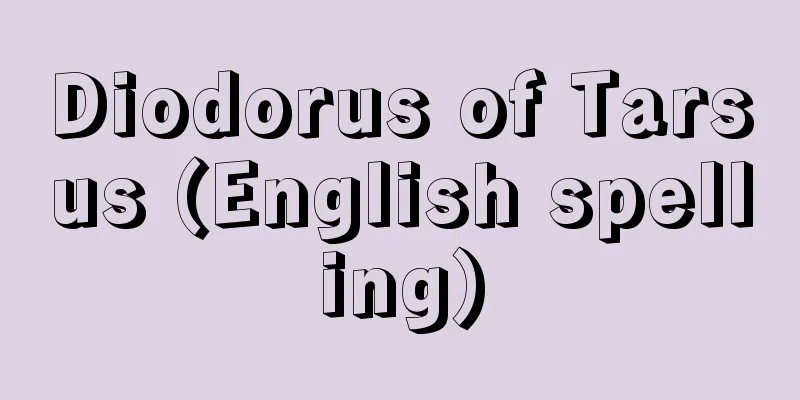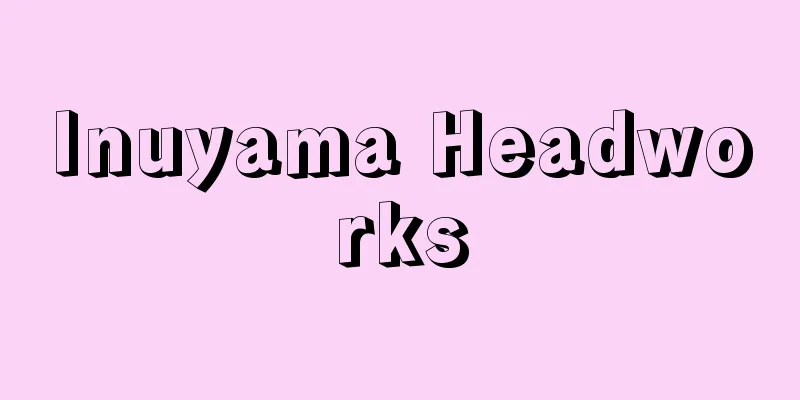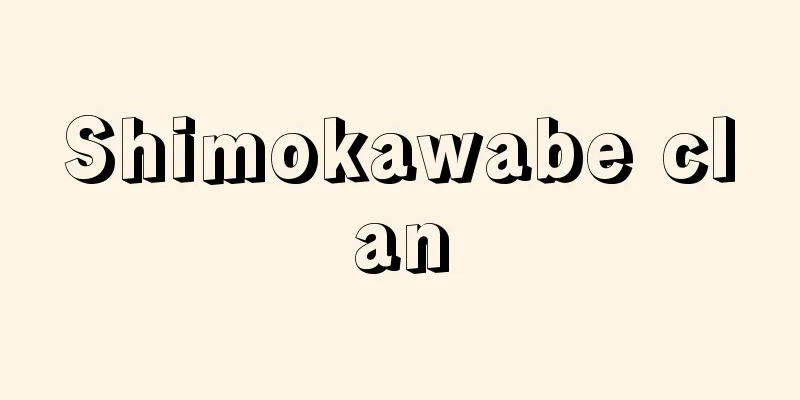Picture book - Ehon

|
In Japan, picture books used to refer to picture scrolls, illustrated handbooks, illustrated storybooks, etc. in the past, but as times changed, the term has come to mean children's books that mainly feature pictures. They are diverse in both form and content, ranging from those that are expressed only with pictures, to those with pictures as the main pillar and a few words added, to those in which pictures and text complement each other equally to tell a single story, and even picture story-style books in which the proportion of text increases and illustrations are added. The subjects they deal with are not limited to folk tales or fictional stories, but cover a wide range of subjects, including letters, words, nature, science, and society. Furthermore, with the development of graphic arts, the form of expression and content have become more sophisticated, and they are now aimed at adults as well as children. [Shigeo Watanabe and Atsuo Saito February 18, 2019] The joy of picture booksThis is a commonly used expression regarding the formation of reading habits that begin in childhood, but it is even said that "picture books are the first books a person encounters in his or her long reading life. Whether or not a child finds enjoyment in picture books during childhood determines whether or not he or she will become a lifelong book lover" (Dorothy Neal White, 1915-1995). [Shigeo Watanabe and Atsuo Saito February 18, 2019] Enjoy playingJust as there is no motive or pattern for play, there is no motive or pattern for young children to interact with picture books. A child's inner life expands as they freely look at a picture book, turn the pages, listen to the reader's voice, laugh, feel surprised, or enjoy thinking. Children's play is inherently free-spirited, whether it be physical play or imaginative play. A good picture book lets children play, liberating them from the constraints of everyday life. Examples include "Guri and Gura" (written by Nakagawa Rieko, illustrated by Omura Yuriko, 1963), "My One Piece" (written and illustrated by Nishimaki Kayako, 1969), "Jupta the Fire Engine" (written by Watanabe Shigeo, illustrated by Yamamoto Tadataka, 1966), "Chu-Chu the Naughty Train" (written and illustrated by Burton, translated by Muraoka Hanako, 1937), "The Mischievous Monkey" (written and illustrated by Ray, translated by Mitsuyoshi Natsuya, 1954), and "Muddy Harry" (written by Geon, illustrated by Graham, translated by Watanabe Shigeo, 1964) (the numbers in parentheses are the years when the first editions were published; same below). [Shigeo Watanabe and Atsuo Saito February 18, 2019] Enjoy your fantasyChildhood is characterized by the freedom to move between reality and fantasy. Talking to stuffed animals, flowers, and stones is the sensibility of childhood, when we see others as living beings just like ourselves. Even though it is impossible for the little protagonist to meet lions, bears, storks, monkeys, rabbits, and other animals in the forest and have picnics and play hide-and-seek with them, "In the Forest" (written and illustrated by Ets, translated by Masaki Ruriko, 1963) not only allows the reader to play in the forest, but also revives the childlike spirit of adults. As in "The Mitten" (Ukrainian folk tale, illustrated by Rachev, translated by Uchida Risako, 1965), it is impossible for animals large and small, such as mice, frogs, wolves, and bears, to fit into a single glove found in the forest, but the reader does not feel any strangeness, and instead enters the glove like the animals and feels the warmth. The secret lies in the imaginative artist's brush strokes, whose expressiveness makes the world's most mysterious events seem real, and this art nurtures children's imagination. [Shigeo Watanabe and Atsuo Saito February 18, 2019] Enjoy the picturesWhether it is "Choju Jinbutsu Giga" (Cartoon Paintings of Animals), said to have been created by Toba Sojo, or a picture book by Randolph Caldecott (1846-1886), the illustrations beautifully tell the story through the dynamic figures and expressions, composition and colors of the drawings. Even young children who cannot read can read such excellent picture books through the pictures. In a well-finished picture book, the pictures and text are integrated to tell the entire story, from beginning to end. Following the movement and flow of the story, the picture book connects and expresses the emotional ups and downs and rhythm, creating an uninterrupted flow. Picture books like this capture children's interest and do not let go. When giving a child his first picture books, some of them should be pure, bright, and cheerful in color, with excellent composition and clear lines and shapes. These provide a child with his first aesthetic experience through color and shape. For example, the Little Bunny series (written and illustrated by Bruna, translated by Ishii Momoko and Matsuoka Kyoko, 1964) gives shape to bright red, eye-catching green, vibrant yellow, clear blue, and pure white, all of which are given shape with thick black lines. A child's sense of color, like other senses, develops from what is given to them. They will come to appreciate beauty not only in simple and clear combinations of colors and shapes, but also in light and shade, brilliant and striking colors, strong and smooth lines, and in intricate and subtle lines. Picture books help this development. [Shigeo Watanabe and Atsuo Saito February 18, 2019] Enjoying words and storiesChildren love simple, powerful, and bright, pleasant-sounding words. In the West, there are many excellent picture books of Mother Goose songs (nursery rhymes), including Caldecott's picture books, and they are regarded as enjoyable word books for young children, but because they are difficult to translate, they have hardly been introduced in Japan. In Japan, there are several works by Kishida Eriko (1929-2011), such as "Hippo-kun" (illustrated by Nakatani Chiyoko, 1962), several works by Tanikawa Shuntaro, such as "Kotoba Asobi Uta" (illustrated by Segawa Yasuo, 1973), and "Nazo Nazo Ehon" (written by Nakagawa Rieko, illustrated by Yamawaki Yuriko, 1988), but there is no outstanding picture book of nursery rhymes yet. This is one of the challenges for the future. Regardless of the main character of a picture book, a good picture book has both powerful pictures and text that give it a sense of life. Even just a few lines of good text can convey this power. One example is the line from "The Giant Turnip" (a Russian folk tale retold by Uchida Risako, illustrated by Sato Churyo, 1962): "The mouse pulls the cat, the cat pulls the dog, the dog pulls the grandchild, the grandchild pulls the grandmother, the grandmother pulls the grandfather, the grandfather pulls the turnip -- up, up, up, up." Good writing is concise, making use of the meaning and feel of the words, without the unnecessary use of onomatopoeia. This gives the writing a pleasant sound and rhythm. Appropriate repetition also enhances the tone of the story. Writing of this type draws children into the world of the story while cultivating their sense of language. It is the narrative that breathes life into the subject matter of a picture book, and a story with a solid structure makes for an excellent picture book. Examples include "Once Upon a Time in the Crab" (written by Kinoshita Junji, illustrated by Shimizu Kon, 1959), "The Train Yaemon" (written by Agawa Hiroyuki, illustrated by Okabe Fuyuhiko, 1959), and "The Yamanba no Nishiki" (written by Matsutani Miyoko, illustrated by Segawa Yasuo, 1969). [Shigeo Watanabe and Atsuo Saito February 18, 2019] Enjoy the atmospherePicture books that allow children to enjoy fantasy and beauty appeal to children's emotions. Human emotions are richly fluctuating, and love blossoms there, poetry and literature are born, and art has flourished. The delicate love in works such as "The White Rabbit and the Black Rabbit" (written and illustrated by Williams, translated by Kyoko Matsuoka, 1965) and "Snowy Day" (written and illustrated by Keats, translated by Hajime Kijima, 1969), the sense of mystery in "Sleeping Beauty" (Grimm's Fairy Tales, illustrated by Hoffmann, translated by Teiji Seta, 1963), the humor in "Eleven Cats" (written and illustrated by Noboru Baba, 1967), and the kindness in "Play with Me" (written and illustrated by Etz, translated by Junichi Yoda, 1968) are all good examples of works that foster children's emotions. [Shigeo Watanabe and Atsuo Saito February 18, 2019] Intellectual funWhile illustrated books and photo books satisfy children's intellectual curiosity, unique picture books provide intellectual enjoyment to both children and adults. Good examples include "Fushiginae" (illustrated by Mitsumasa Anno, 1971), "Tabi no Ehon" (Travel Picture Book) (same publisher, 1977), and "Watashi" (written by Shuntaro Tanikawa and illustrated by Shinta Naga, 1981). [Shigeo Watanabe and Atsuo Saito February 18, 2019] Japanese Picture BooksPremodern picture booksThe origins of Japanese picture books lie in the picture scrolls of the first half of the 12th century Heian period. The Tale of Genji Illustrated Scroll, which uses vibrant colors to depict an indoor encounter between a man and a woman, and Choju Jinbutsu Giga, which uses vibrant, light-colored brushstrokes to depict the playful antics of animals in the mountains and fields, are two of the oldest masterpieces of illustrated narrative. In the latter half of the same period, masterpieces comparable to these two works were produced: Shigisan Engi and Ban Dainagon Ekotoba. In the Nanboku-cho period and the Muromachi period, amid the rise and development of folk performing arts, communication stories such as "Teikinourai," which is considered the origin of textbooks, were written, and Otogi-zoshi (fairy tales) became popular. Over 500 popular short stories were written, with a wide variety of content, including folk tales, legends, and adventure tales. During the Muromachi period, Nara artists used these Otogi-zoshi as subject matter to create picture scrolls and booklets, which eventually came to be called Nara ehon (Nara picture books). The early large books, which were booklets made to the same size as picture scrolls, were beautiful books with stories written in beautiful calligraphy on high-quality paper and illustrated in brilliant colors using vermilion, green, yellow, gold and silver leaf, and were read by women of upper class society. From 1615 (Genwa 1) through the 1630s (Kan'ei), these works were imitated and printed, hand-colored with two colors, vermilion and green, sometimes mixed with yellow, in a single brush stroke, and these became known as tanrokubon, or "tanroku editions." In the 17th century, Honami Koetsu and other artists of the time produced lavish Sagabon editions, and the Sagabon Tales of Ise Emaki became the first illustrated literary book. Inspired by the Sagabon editions, the popularity of the Tanryokubon editions led to the birth of the Akabon editions as popular culture blossomed in Edo, but at the same time, Nakamura Tekisai's Kinmō Zui (1666) was born as an attempt to educate the people. Kinmō Zui can be considered the beginning of illustrated encyclopedias, and following Jinrin Kunmō Zui, it was eventually compiled into Wakan Sansai Zue (1713). The age of ukiyo-e began with Hishikawa Moronobu at the end of the 17th century. Moronobu created ukiyo-e picture books, with pictures as the main focus and text as the secondary focus, in which readers can enjoy the pictures themselves while following the story, becoming Japan's first picture book author. Through his works, he pioneered the genre of genre painting known as "ukiyo-e." Around the same time, picture models based on Chinese paintings were also created. The 40 years between the 17th and 18th centuries were the period of the early development of akahon, with the Kyoho era (1716-1736) being said to be its golden age. One reason for this is that, due to the influence of the times, talented picture book authors competed to show off their skills in the akahon children's picture books. The main authors were Kondo Kiyoharu (years of birth and death unknown), Okumura Masanobu, Nishimura Shigenaga (1697?-1756), Nishikawa Sukenobu, Kitao Shigemasa, and Kitao Masayoshi. Following the Akahon, Kusazoshi books with changing cover colors such as Kurohon (black) and Aohon (light green) appeared, and the content also began to change to be more geared towards adults, until in the latter half of the 18th century they became fully adult picture books. It was during this period that the same artists started to develop genres of play pictures, or toy pictures, such as shadow pictures, eye pictures, letter pictures, inlay pictures, double-sided pictures, kite pictures, and riddle pictures. In addition, traditional picture books and the tradition of ornately decorated Nishikie (colored woodblock prints) are also important parts of the ancient picture book art, but from popular art such as yellow-covered books and reading books, many masterpieces of ukiyo-e picture books were born, including Hokusai Katsushika's "Hokusai Manga" and "Ehon Fugaku Hyakkei," and Hiroshige Utagawa's "Ehon Edo Miyage." Hokusai gave his child "Ehon Saishikitsu," saying, "For children who love painting, I have created a small booklet using only the easiest colors," and Hiroshige also compiled a children's picture manual, "Sohitsu Gafu," and drew many Sugoroku (backboard games) and toy pictures such as "Shinban Kageboshi Zukushi." Also of his time, Utagawa Kuniyoshi produced many unrestrained masterpieces of toy pictures and warrior paintings, which influenced warrior picture books of the late Edo period. Children's books in the Edo period were the story picture books that we have mentioned so far, the picture books, the warrior picture books, the omochae, and the red books. This last style continued to produce the so-called five great stories, such as "Momotaro", "Hanasakajijii", "Sarukanigassen", "Kachikachiyama", and "Suzume no Suzume", as well as old tales such as "Bunpuku Chagama" and "Kintaro", and became the typical old tale picture book that was handed down to the Meiji period. [Shigeo Watanabe and Atsuo Saito February 18, 2019] Modern picture booksThe tradition of omochae (toy pictures) inherited from the Edo period became educational nishikie (colored woodblock prints) in the Meiji era, when Western printing techniques were introduced and national education began. They were used as supplementary materials for textbooks. Picture books for teaching Western painting techniques were also adopted as drawing textbooks. In 1885 (Meiji 18), many Japanese folk tales, including the Five Great Tales, were translated by foreigners living in Japan, such as B. H. Chamberlain and Florenz Karl (1865-1939), and illustrated by Kobayashi Eitaku (1843-1890) and others. The translated works were published as crepe paper books as souvenirs for foreigners by Kobundo, a publisher run by Hasegawa Takejiro (1853-1938). This is a noteworthy publication both in the history of picture books and in the history of translation. Also important from the perspective of illustrations were the successive publication of two children's magazines: "Shounen-en" (1888), modelled on the British children's magazine "Little Folks," and "Shokokumin" (1889), modelled on the American magazine "Young People." These magazines featured illustrations by such talented artists as Kobayashi Kiyochika and Takeuchi Keishu. From the mid-Meiji period onwards, new printing techniques such as lithography, screen printing, three-colour printing and zinc plate printing developed in relation to illustration techniques, and illustration for children's books came to be considered a special field. In terms of content, the rise of children's literature, led by Iwaya Sazanami, also had a major impact on the progress of illustration. Starting with Takeuchi Keishu's frontispiece for Sazanami's debut work Koganemaru, the work of Kiyochika, Kaburaki Kiyokata and other famous artists of the time, who illustrated Shonen Bungaku Sosho, Nihon Mukashi Banashi and Shonen Sekai, edited by Sazanami, was a major stimulus, and many artists applied their brushes to Shonen Chishiki Gaho, Shojo Chishiki Gaho and Yonnen Gaho, and Yonnen Gaho gave birth to an independent small-sized picture book, Nakanishiya's Nihonichi no Ebanashi, a total of 35 volumes. In the Taisho era, with the heyday of children's magazines, artists played a part in creating the image of the magazines and left behind excellent works, such as "Nihon Shonen" and "Shin Shojo" and Takehisa Yumeji, frame illustrator Watanabe Yohei (1888-1912), "Kodomo no Tomo" and Kitazawa Rakuten, "Kodomo" and Kawakami Shiro and Kawame Teiji (1889-1958), "Mohan Katei Bunko" and Okamoto Kiichi, "Akai Tori", "Kodomo no Kuni", "Kinder Book" and Shimizu Yoshio, Murayama Tomoyoshi, and Takei Takeo. Eventually, the Japan Children's Illustrators Association was founded in 1927 (Showa 2) with these artists at its core. Born against the backdrop of the development of children's magazines and the spread of early childhood education, "Kinder Book" became a typical example of a childcare observation picture book, clearly imprinting the image of children's drawings and children's picture books on children in the early Showa period. The opposite of this was the "Kodansha Picture Book," which became a typical example of a picture book, and covered a wide range of subjects such as folk tales, classic masterpieces from Japan and abroad, animals, vehicles, and children's songs, and covered veteran Japanese painters, Western painters, commercial artists, and cartoonists, captivating readers. [Shigeo Watanabe and Atsuo Saito February 18, 2019] Contemporary picture booksAfter the Second World War, Japanese picture books were dominated by "colored candy-like, flashy, gaudy, frightening, and incoherent books" (Seta Teiji, 1916-1979), and could hardly reach the level of some of the excellent picture books produced before the war. However, the influx of American and European picture books after the war shocked the world of Japanese picture books and completely changed its appearance. The picture book series "Iwanami no Kodomo no Hon" (Iwanami Children's Books), first published by Iwanami Shoten in 1953 (Showa 28), has released many masterpieces, including classics such as "Little Black Sambo" (out of print in 1988 due to discriminatory language used, then republished later) by Helen Bannerman (1862-1946), as well as many other masterpieces, mainly from the UK and the US, but also including original picture books by Japanese authors, such as "I Love You Mother" (written and illustrated by Flack, translated by Mitsuyoshi Natsuya, 1954), "Pitch the Kitten" (written and illustrated by Fischer, translated by Ishii Momoko, 1954), "The Animal Congress" (written by Ek Estner, illustrated by Trier, translated by Takahashi Kenji, 1962), "The Little House" (written and illustrated by Burton, translated by Ishii Momoko, 1965), and "Ollie the Sea Ghost" (written and illustrated by Öts, translated by Ishii Momoko, 1974). This opened up a new world of picture books that were fun, new and highly artistic, and purely for children, not just for adults to satisfy. It could be said that this was a new discovery of children through picture books, and the picture books published in series were widely accepted by children, via parents, kindergarten, nursery school and elementary school teachers. At the same time, it showed painters, writers, poets, scientists and photographers who had never previously drawn picture books for children a new place and form of expression in the form of picture books, drawing them in and ushering in the golden age of picture books in the 1960s and 1970s. In addition to the works already mentioned, there are many other picture books that have been highly praised in Japan since the 1960s and 1970s and widely accepted by children. Among the story picture books are "Daruma-chan and Tengu-chan" (written and illustrated by Kako Satoshi, 1967), "The Cat That Lived a Million Times" (written and illustrated by Sano Yoko, 1977), "My First Errand" (written by Tsutsui Yoriko, illustrated by Hayashi Akiko, 1977), "Sobe in Hell" (written and illustrated by Tajima Yukihiko, 1979), "I Hate Hasegawa-kun" (written and illustrated by Hasegawa Shuhei, 1976), "Pika of Hiroshima" (written and illustrated by Maruki Toshi, 1980), and "I Love Baths" (written by Matsuoka Kyoko, illustrated by Hayashi Akiko, 1982). Knowledge picture books include "The Sea" (written and illustrated by Kako Satoko, 1969), "The Story of Chi" (written and illustrated by Horiuchi Seiichi, 1978), and "Beans" (written and illustrated by Hirayama Kazuko, 1981), as well as photo picture books such as "Haru Nire" (photographed by Kakizaki Kazuma, 1981) and "Water" (written by Hasegawa Setsuko, photographed by Hanabusa Shinzo, 1987). There have also been attempts at picture books of poetry, such as "Moco Moco Moco" (written by Tanikawa Shuntaro and illustrated by Motonaga Sadamasa, 1977), "Korokorokoro" (written and illustrated by Motonaga Sadamasa, 1984), and "Counting Song Book" (written by Kishida Eriko and illustrated by Suzuki Koji, 1990). Furthermore, picture books for children aged 0 to 2 or 3, so-called first books, include "Animal Parents and Children" (illustrated by Yabuuchi Masayuki, 1960), "Little Cat" (written by Ishii Momoko and illustrated by Yokouchi Jo, 1967), "Peek-a-boo" (written by Matsutani Miyoko and illustrated by Segawa Yasuo, 1968), "Kuma-kun no Ehon" (written by Watanabe Shigeo and illustrated by Otomo Yasuo, 1980), and "Strawberry" (written and illustrated by Hirayama Kazuko, 1989). The above are just a few examples, but many excellent works were published. There are several possible reasons why so many excellent works were produced during this period, but above all, it was because it became possible to come into contact with foreign picture books not only in translation but also in the original, which greatly increased the creative enthusiasm of artists, writers, and editors, and many new illustrators emerged who made full use of illustration and graphic design techniques learned from foreign picture books, based on traditional Japanese forms of expression and aesthetic sense, in monthly picture book magazines such as Fukuinkan Bookstore's Kodomo no Tomo and Shikosha's Kodomo no Sekai, which followed the Iwanami Children's Books series. The illustrations of Japanese artists were also highly praised in international competitions such as the Biennial of Illustrations Bratislava (BIB). Illustrators who have achieved international renown include Segawa Yasuo (1932-2010), Akaba Suekichi (1910-1990), Anno Mitsumasa, Tajima Seizō (1940- ), Iwasaki Chihiro, Ota Daihachi (1918-2016), Kajiyama Toshio (1935-2015), Sugita Yutaka (1930-2017), and Nakatsuji Etsuko (1937- ), to name just a few. The award of the Hans Christian Andersen Award for Illustration in 1980 for Suekichi Akaba and in 1984 for Mitsumasa Anno, given to an artist for their entire career, marked an international recognition of Japanese picture books, and also a milestone in the development of Japanese picture books after the Second World War, which began with Iwanami Children's Books. Since the 1980s, picture books have expanded in scope, with writers and artists from the 1960s and 1970s such as Akiko Hayashi (1945-), Ken Katayama (1940-), Koji Suzuki (1948-), Wakiko Sato (1937-), Kazuo Iwamura (1939-), and Taro Gomi (1945-). However, as Japan's economy grew, picture book publishing became industrialized, and many books that did not have the maturity to be picture books began to be published, resulting in a sudden flood of picture books and a decline in quality. At the same time, the broadcast of animation on television and its conversion to video have progressed, raising concerns that children are losing interest in picture books. [Shigeo Watanabe and Atsuo Saito] Foreign picture booksThe origin of picture books in Western Europe is said to be Comenius' Orbis Pictus (1658), but it can be said that picture books in the modern sense began in the 19th century. [Shigeo Watanabe and Atsuo Saito February 18, 2019] 19th centuryGeorge Cruikshank (1792-1878) further developed the technique of engraving developed by Thomas Buick, producing children's books with superb illustrations in lithographs and etchings, such as Grimm's Fairy Tales, Robinson Crusoe, and Cinderella. Two books followed shortly after these, Edward Lear's The Nonsense Book (1870) and Heinrich Hoffmann's The Ruffled Peter (1845-1847), two works born of genius and which became classics illustrated by their authors. Three artists, led by the talented late Victorian printer Edmund Evans (1826-1905), produced masterpieces of picture books that gave children the pure joy of reading. These three artists were Walter Crane (1845-1915), who depicted the world of fairy tales with stylized compositions and backgrounds, Randolph Caldecott, who depicted the human drama of nursery rhymes with dynamic, powerful lines against a backdrop of English landscapes and a base of russet green, and Kate Greenaway (1846-1901), who added a feminine delicacy and sweetness to her works. During the same period, in France, Gustave Doret produced Don Quixote and Perrault's Fairy Tales, while Maurice Boutet de Monvel (1850-1913) used lithography to produce intricate illustrations for Joan of Arc and other works. In Germany, Wilhelm Busch published Max and Moritz, and the Swiss Ernst Kreidolf (1863-1956) began illustrating his Flower Fairy Tales. In America, Howard Pyle added dramatic copperplate engravings to his own retellings of medieval knight tales. During this period, picture books became more diverse in style, more appealing, relatively inexpensive, and more technically advanced, rapidly increasing their young readership. [Shigeo Watanabe and Atsuo Saito February 18, 2019] 20th centuryIn the 20th century, picture books made remarkable progress due to the advancement of photoengraving and other printing technologies. Artistic picture books were produced by such authors as Beatrix Potter's Peter Rabbit, a masterpiece of small animals with vivid watercolors, Arthur Rackham (1867-1939), who used subdued colors to depict the fantastic world of fairy tales, and Edmund Dulac (1882-1953), who used miniature painting techniques. Leslie Brooke's (1862-1940) Johnny Crow's Garden, in which animals tell the story with humorous gestures, is an outstanding example of a picture book in which the pictures tell the story. One of the characteristics of picture books in the first half of the 20th century was the harmony between pictures and text, where pictures complement the story told in text, as in Angus and the Ducklings by Marjorie Flack (1897-1958), or provide rhythm and accompaniment to the story, as in Wanda Garg's One Hundred Thousand Cats. The invention of offset printing also continued to nurture such story-rich picture book authors, producing excellent picture book authors such as Edward Ardizzone of Tim the Brave Detective, Virginia Lee Burton of The Little House, Jean de Brunhoff of Babar the Elephant, and Hans Fischer (1909-1958) and Felix Hoffmann (1911-1975), who illustrated fairy tale picture books in Switzerland. Other authors who depicted children's experiences with great emotion, such as Marie Hall Etz with "In the Woods," Robert McCloskey with "Morning by the Sea" and "A Wonderful Time," and Ezra Jack Keats (1916-1983) with "A Snowy Day," depicted childhoods filled with love and comfort, and were typical of picture books of the same period. The excellent French educational picture book "The Books of Père Castor" was also created from the same warm educational perspective. になったんです。 English: The first thing you can do is to find the best one to do. になったんです。 English: The first thing you can do is to find the best one to do.になったんです。 English: The first thing you can do is to find the best one to do. In other words, as a form of expression, picture books are certainly already out of the scope of children's books, but picture books that are widely accepted with joy not only by children but also adults, and still survive for a long time have not changed in their essence from the time of Coldecott to the present. Since the 1990s, digitalization of picture books has also begun, and there are concerns that children will be able to move away from picture books, but the true reason for the disparity between children is that children do not read them. What is concerning is not the animation or digitalization of picture books, but the issue of the difference between adults and children, especially parents and children. [Watanabe Shigeo and Saito Atsuo] になったんです。 English: The first thing you can do is to find the best one to do . "Nakamura Masako, Picture Books Are Friends" (1997, Fukuinkan Shoten)" ▽ "Watanabe Shigeo, "Sowing Green Seeds in the Heart - The Fun of Picture Books" (1997, Shinchosha, later Shincho Bunko, Iwanami Gendai Bunko)" ▽ "Brian Alderson, translated by Yoshida Shinichi, "Singing the Song of Sixpence: Traditions and Cold Decotts of British Picture Books" (1999, Japan Editor School Publishing Department)" [Reference Items] | | | | | |Iwatani |Ukiyo-e | | | |Epic | | | | Kaburagi Kiyokata |Kawakami Shiro | | Cover | | |Tale | | | | | | | | | | | Tanikawa Shuntaro | | | | | | | | | | | | | | Japanese andSuzakuin, a monk, visits Rokujoin, worried about his beloved daughter San's Shrine. San's Shrine, who is troubled by his affair with Kashiwagi, replies to his father to become a monk. Genji also sadly suffers from a misunderstanding with his wife San's Shrine. The feelings of the three of them are symbolically expressed through the lines of the screen, which are placed in unconventional terms. Stock Photo: The National Diet Library "> "The Tale of Genji Picture Scroll" (Kashiwagi 1) Toikura's volume. The scene that begins in the story, in which the bowl that Mineren flew away, even Yamazaki's best friend, Yonekura, is transported to Mt. Shigiyama. Collection of the National Diet Library "> "Shigiyama Engi Picture Scroll" Hearing the flames of Otenmon, he rushes through Suzaku Gate to the fire ground, stops and looks up at the fire smoke. Collection of the National Diet Library "> "Bon Dainagon Pictures" Volume 1, published in 1690 (Genroku 3), held by the National Diet Library "> "Man-in-Long-Term Illustrations" Volume 1 "Astronomical Planet" Edited by Terashima Ryoyasu, published in 1715 (Shotoku 5), held by the National Diet Library "> "Japanese and Chinese Sanseizue" (Astronomical) Hishikawa Momo no Mission published in 1684 (Tenwa 4) (re-engraved Tenwa 2 edition) held by the National Diet Library "> "Ukiyosei" Source: Shogakukan Encyclopedia Nipponica About Encyclopedia Nipponica Information | Legend |
|
日本では、古くは絵巻、絵手本、絵草紙(えぞうし)などを絵本と称し、時代の変遷につれ、絵を中心とする子供の本を意味するようになった。表現形式、内容ともに多様であり、絵のみで表現するものに始まり、絵を柱として数語のことばを添えたもの、絵と文章が対等に補完しあい、一つの物語を語るもの、さらに文章の比重が増え、それに挿絵をつけた絵物語形式のものまで含まれる。取り扱う題材も、昔話や創作の物語に限られず、文字、ことば、自然、科学、社会などあらゆる領域にわたっている。また、グラフィック・アートの発展とともに表現形式、内容が高度化し、読者を子供に限らず大人をも対象とするようになった。 [渡辺茂男・斎藤惇夫 2019年2月18日] 絵本の楽しみ子供時代に始まる読書習慣の形成に関して、だれもが口にするようになった表現であるが、「絵本は、人間の長い読書生活のなかで、初めて出会う本である。子供時代に、その子が、絵本のなかに楽しみをみいだすかどうかで、生涯、本好きになるかどうか決まる」(ドロシー・ホワイトDorothy Neal White、1915―1995)とさえいわれる。 [渡辺茂男・斎藤惇夫 2019年2月18日] 遊びを楽しむ遊びに動機や型がないように、幼い子供が絵本に接することに動機や型はない。のびやかに絵本を眺め、ページをめくり、読み手の声に耳を傾け、笑い、驚き、あるいは考える楽しさで、その子の内面生活が広がっていく。本来子供の遊びは、体を動かす遊びでも、空想的な遊びでも、自由奔放である。優れた絵本は、子供を遊ばせ、日常の束縛から子供を解放する。『ぐりとぐら』(中川李枝子(りえこ)文、大村百合子(ゆりこ)絵・1963)、『わたしのワンピース』(西巻茅子(かやこ)文・絵・1969)、『しょうぼうじどうしゃじぷた』(渡辺茂男文、山本忠敬絵・1966)、『いたずらきかんしゃちゅうちゅう』(バートン文・絵、村岡花子訳・1937)、『ひとまねこざる』(レイ文・絵、光吉夏弥訳・1954)、『どろんこハリー』(ジオン文、グレアム絵、渡辺茂男訳・1964)などその例である(括弧(かっこ)内の数字は初版発行年。以下同)。 [渡辺茂男・斎藤惇夫 2019年2月18日] 空想を楽しむ子供時代の特徴は、現実と空想の間を自由に行き来することである。縫いぐるみの動物に話しかけ、花や石に話しかけるのは、相手を自分と同じように生きているとみる幼い時代の感性である。小さな主人公が、森の中で、ライオンやクマやコウノトリやサルやウサギや、そのほかの動物たちに出会い、いっしょにピクニックをしたり、かくれんぼをしたりすることは現実にありえないとしても、『もりのなか』(エッツ文・絵、間崎ルリ子訳・1963)は、読者の子供を森の中で遊ばせてくれるばかりか、大人の童心をもよみがえらせる。『てぶくろ』(ウクライナ民話、ラチョフ絵、内田莉莎子(りさこ)訳・1965)のように、ネズミやカエルやオオカミやクマなどの大小の動物たちが、森の中に落ちていたたった一つの手袋に入れるはずはないが、読者は、なんの不思議も感じないどころか、動物たちのように手袋の中に入って、暖かさを感じたりする。この秘密は、空想力豊かな画家の絵筆の動きにあり、その表現力が、世にも不思議なできごとをリアルにみせるのであり、この芸術が子供の空想力を育てる。 [渡辺茂男・斎藤惇夫 2019年2月18日] 絵を楽しむ鳥羽(とば)僧正の作といわれる『鳥獣人物戯画』であれ、コールデコットRandolph Coldecott(1846―1886)の絵本であれ、躍動する素描の描き出す姿態と表情、構図と色彩によって、絵がみごとに物語を語る。文字を読めない幼い子供でさえ、このような優れた絵本を絵によって読むことができる。完成度の高い絵本では、絵と文章が一体となって、物語の起承転結すべてを語る。物語の動きに従い、流れに沿って、絵本は、その感情の起伏やリズムを連結して表現し、流れをとぎらせない。このような絵本は子供の興味をひきつけて離さない。 子供に初めて絵本を与えるとき、その何冊かは、混じりけのない、明るい、晴れ晴れとした色の絵本がよい。そして、構図の優れた、明確な線と形。子供にとって初めての美的経験を色と形で与える。たとえば『ちいさなうさこちゃん』(ブルーナ文・絵、石井桃子・松岡享子(きょうこ)訳・1964)シリーズ。明るい赤、目の覚めるような緑、晴れやかな黄、澄んだ青、混じりけのない白、これに太い黒線で形を与えている。子供の色彩感覚は、他の感覚同様、与えられたもので育つ。単純明快な色や形の組合せばかりでなく、濃淡の陰影、目もあやな華麗な色彩、力強くよどみのない線、また精緻(せいち)微妙な線にも美しさを感ずるようになる。絵本は、その成長を助ける。 [渡辺茂男・斎藤惇夫 2019年2月18日] ことばと物語を楽しむ子供たちは、素朴な、力強い、そして明るく響きのよいことばを愛する。欧米ではコールデコットの絵本をはじめとして、マザーグースの歌(わらべうた)の絵本で優れたものが多く、幼い子供たちのための楽しいことばの本としての位置を占めているが、翻訳が困難なため日本にはほとんど紹介されていない。日本の絵本では『かばくん』(中谷千代子絵・1962)をはじめとした岸田衿子(えりこ)(1929―2011)のいくつかの作品、また『ことばあそびうた』(瀬川康男(やすお)絵・1973)をはじめとした谷川俊太郎のいくつかの作品、そして『なぞなぞえほん』(中川李枝子作、山脇百合子絵・1988)などあるが、わらべうたの絵本で、これという作品はまだ生まれていない。これからの課題の一つである。 絵本の主人公がなんであれ、優れた絵本は、絵と文章ともに力があり、生命を感じさせる。優れた文章は、ほんの数行抜き書きしただけでも、この力を感じさせる。たとえば『おおきなかぶ』(ロシア民話、内田莉莎子再話、佐藤忠良絵・1962)における「ねずみが ねこを ひっぱって、ねこが いぬを ひっぱって、いぬが まごを ひっぱって、まごが おばあさんを ひっぱって、おばあさんが おじいさんを ひっぱって、おじいさんが かぶを ひっぱって――うんとこしょ どっこいしょ」がその一例である。 擬音をむやみに使わずに、ことばの意味と語感を生かして簡潔であるのが、よい文章である。そこから快い響き、リズムが聞こえてくる。また、適度の繰り返しも物語の調子を高める。このような文章は、子供の、ことばに対する感覚を養いながら、物語の世界に引き入れていく。絵本の題材に生命力を吹き込むのは物語性であり、骨組みのしっかりした物語が優れた絵本をつくる。『かにむかし』(木下順二文、清水崑(こん)絵・1959)、『きかんしゃやえもん』(阿川弘之(ひろゆき)文、岡部冬彦絵・1959)、『やまんばのにしき』(松谷みよ子文、瀬川康男絵・1969)などその例である。 [渡辺茂男・斎藤惇夫 2019年2月18日] 情緒を楽しむ子供が空想を楽しみ、美しさを楽しむ絵本は、子供の情感に働きかける。人間の情感は、豊かに揺れ動き、そこに愛が芽生え、詩や文学が生まれ、芸術が育ってきた。『しろいうさぎとくろいうさぎ』(ウィリアムズ文・絵、松岡享子訳・1965)、『ゆきのひ』(キーツ文・絵、木島始訳・1969)などの細やかな愛情、『ねむりひめ』(グリム童話、ホフマン絵、瀬田貞二訳・1963)の神秘感、『11ぴきのねこ』(馬場のぼる文・絵・1967)のユーモアや『わたしとあそんで』(エッツ文・絵、与田凖一訳・1968)の優しさは、子供の情緒をはぐくむ好例である。 [渡辺茂男・斎藤惇夫 2019年2月18日] 知的な楽しみ図鑑や写真集は、子供の知的好奇心を満足させるが、個性的な絵本は、子供大人を問わず、知的な楽しみを与えてくれる。『ふしぎなえ』(安野光雅(あんのみつまさ)絵・1971)、『旅の絵本』(同・1977)、『わたし』(谷川俊太郎文、長新太絵・1981)などその好例である。 [渡辺茂男・斎藤惇夫 2019年2月18日] 日本の絵本近代以前の絵本日本の絵本の源は、平安時代12世紀前半の絵巻にある。あでやかな色彩で屋内の男女の出会いを描いた『源氏物語絵巻』と、躍動する淡彩の筆の動きで山野の動物の楽しいふるまいを描いた『鳥獣人物戯画』は、最古の物語絵の二大傑作である。同時代後半に、これら2作に比すべき『信貴山縁起(しぎさんえんぎ)』と『伴大納言絵詞(ばんだいなごんえことば)』の傑作が生まれた。 南北朝時代と室町時代の、庶民芸能の勃興(ぼっこう)と発達の流れのなかで、教科書の始祖とも考えられる『庭訓往来(ていきんおうらい)』をはじめとする往来物が書かれ、御伽草子(おとぎぞうし)が流行する。およそ500編を超える通俗的な短編物語が書かれ、その内容も昔話、伝説、冒険談など多種多様であった。室町時代、奈良の絵師たちが、これらの御伽草子を題材として絵巻物に仕立てたり冊子本につくったりして、やがて奈良絵本と呼称されるようになった。絵巻物の御伽草子や絵巻物のサイズをそのままに冊子にした初期の大型本は、上質の紙に能筆で書かれた物語に朱、緑、黄、金銀箔(はく)など用いて極彩色の挿絵を入れた美麗な本で、上流社会の女性の読み物であった。1615年(元和1)から1630年代(寛永)にかけて、これらを模して版本とし、丹緑(たんろく)(朱と緑)の2色、ときには黄を混ぜて、一刷毛(はけ)の手彩色を施して、庶民の手に渡ったのが丹緑本であった。 17世紀に入ると、本阿弥光悦(ほんあみこうえつ)など当時の美術家の手になる豪華な嵯峨本(さがぼん)がつくられ、『嵯峨本伊勢(いせ)物語絵巻』は、初めての挿絵入り文学本となった。嵯峨本に刺激された丹緑本の普及は、江戸での庶民文化の開花とともに赤本を生み出すことになるが、同時に教化的な試みのなかから中村惕斎(てきさい)による『訓蒙図彙(きんもうずい)』(1666)が生まれた。『訓豪図彙』は図解百科の嚆矢(こうし)ともいうべきもので、『人倫訓蒙図彙』を経て、やがて『和漢三才図会(ずえ)』(1713)に集大成される。 17世紀末から菱川師宣(ひしかわもろのぶ)により浮世絵の時代が始まる。師宣は、絵を主、文章を従とし、物語を追いながら絵そのものを楽しむ浮世絵絵本をつくり、日本初の絵本作家となった。そして作品を通じて「浮世絵」という風俗絵画のジャンルを開いた。同じころ中国の絵画をもとにして絵手本もつくられた。17世紀と18世紀の境の40年間が赤本の草創発展の時期であり、とくに享保(きょうほう)時代(1716~1736)が黄金時代といわれる。時代の影響で、有能な絵本作家が、子供絵本の赤本に競って腕を振るったことも一つの原因である。おもな作家は、近藤清春(きよはる)(生没年未詳)、奥村政信(まさのぶ)、西村重長(しげなが)(1697?―1756)、西川祐信(すけのぶ)、北尾重政(しげまさ)、北尾政美(まさよし)などであった。赤本に続き、表紙の色の変化により黒本(黒色)、青本(萌黄(もえぎ)色)などの草草紙(くさぞうし)が出現し、内容も大人を意識したものに変わり始め、18世紀後半の黄表紙に至ると完全に大人の絵本になる。 またこの時代、同じ絵師たちにより、影絵、目付(めつけ)絵、文字絵、嵌(はめ)絵、両面絵、凧(たこ)絵、判じ絵などの遊び絵、あるいはおもちゃ絵のジャンルが始められた。 そのほか、正統的な画本や、華美な装飾風の錦絵(にしきえ)の伝統なども、古来の絵本芸術を形成する重要な部分であるが、黄表紙、読本(よみほん)などの庶民芸術のなかから、葛飾北斎(かつしかほくさい)の『北斎漫画』『絵本冨嶽(ふがく)百景』、歌川広重(ひろしげ)の『絵本江戸土産(みやげ)』その他数多くの傑作浮世絵絵本が生まれた。北斎は「画を好む児童の為(ため)にとて、成し安き彩色のみをくり出して一小冊となし」と『絵本採色通(さいしきつう)』を子供に贈り、広重も子供向きの絵手本『草筆画譜』をまとめ、多くの双六(すごろく)やおもちゃ絵「新板かげぼしづくし」などを描いた。また同時代の歌川国芳(くによし)は、おもちゃ絵、武者絵の奔放な傑作を多くものし、幕末の武者絵本に影響を与えた。 江戸時代の子供の本は、これまでに触れた往来物、絵手本、武者絵本、おもちゃ絵、そして赤本以来続く物語絵本であった。この最後の形式が『桃太郎』『花咲爺(はなさかじじい)』『猿蟹(さるかに)合戦』『かちかち山』『舌切り雀(すずめ)』の、いわゆる五大咄(ばなし)や、『文福茶釜(ちゃがま)』『金太郎』などの昔話を送り続け、明治に引き継がれる昔話絵本の典型となった。 [渡辺茂男・斎藤惇夫 2019年2月18日] 近代の絵本江戸時代から引き継がれたおもちゃ絵の伝統は、明治の文明開化の流れのなかで、西洋印刷術の導入や国民教育の開始と相まって教育錦絵となり、教科書の補助教材として重用された。また洋画法を教える絵手本も図画の教科書として採用された。 1885年(明治18)五大咄をはじめ数多くの日本昔話が、B・H・チェンバレン、フローレンツKarl Florenz(1865―1939)など在日外国人の訳文で小林永濯(えいたく)(1843―1890)その他の挿絵を添え、長谷川武次郎(はせがわたけじろう)(1853―1938)経営の弘文堂から、外国人の土産(みやげ)用に縮緬本(ちりめんぼん)として出版されたのは、絵本史のうえからも翻訳史のうえからも特筆に値する。また挿絵の側面からも重要なのは、イギリスの児童誌『リトル・フォークス』をモデルにした『少年園』(1888)、アメリカの『ヤング・ピープル』をモデルにした『少国民』(1889)の2冊の児童雑誌が相ついで発刊されたことで、小林清親(きよちか)、武内桂舟(けいしゅう)らの優れた画家が挿絵をつけた。 明治中期以降の石版、網目写真版、三色刷、亜鉛版(ジンク版)印刷など新しい印刷術と挿絵技法の関連する発展過程のなかで、子供の本の挿絵が特別の分野として考えられるようになった。また内容的には、巌谷小波(いわやさざなみ)を先導とする児童文学の隆盛が挿絵の進歩にも大きく影響した。小波の処女作『こがね丸』の武内桂舟の口絵に始まり、小波編集の『少年文学叢書(そうしょ)』『日本昔噺(むかしばなし)』『少年世界』などに挿絵をかいた清親、鏑木清方(かぶらききよかた)その他当時の著名な画家の仕事が大きな刺激となり、多くの画家が『少年知識画報』『少女知識画報』『幼年画報』などに画筆を振るい、『幼年画報』からは、独立した小型の絵本、中西屋の『日本一ノ画噺(えばなし)』全35冊が生まれた。 大正時代、子供雑誌の全盛とともに、『日本少年』『新少女』と竹久夢二、コマ絵の渡辺与平(1888―1912)、『子供之友』と北沢楽天、『コドモ』と川上四郎・河目悌二(かわめていじ)(1889―1958)、『模範家庭文庫』と岡本帰一、『赤い鳥』『コドモノクニ』『キンダーブック』と清水良雄(よしお)・村山知義(ともよし)・武井武雄など、雑誌のイメージづくりに画家が一役を買い、同時に優れた仕事を残した。やがてこれらの画家を中心として、1927年(昭和2)日本童画家協会が設立された。 児童雑誌の発展、幼児教育の普及を背景に生まれ、保育観察絵本の典型となった『キンダーブック』は、童画と幼児絵本のイメージを昭和初期の子供たちに、はっきりと刻みつけた。これと対(つい)をなす絵本の典型となったのが「講談社の絵本」であり、昔話、内外の古典的名作、動物、乗り物、童謡など素材も多岐にわたり、日本画家、洋画家、商業美術家、漫画家のベテランを網羅して読者を魅了した。 [渡辺茂男・斎藤惇夫 2019年2月18日] 現代の絵本第二次世界大戦後の日本の絵本は「着色菓子のようなもの、ピラピラしたもの、けばけばしいもの、おどかすだけのもの、支離滅裂なもの」(瀬田貞二、1916―1979)が横行し、戦前のいくつかの優れた絵本のレベルにも到底及びがたかった。しかし、戦後のアメリカやヨーロッパの絵本の流入は、そうした日本の絵本の世界に衝撃を与え、その様相を一変させた。1953年(昭和28)に岩波書店から創刊された「岩波の子どもの本」の絵本シリーズは、バナーマンHelen Bannerman(1862―1946)原作の『ちびくろ・さんぼ』(差別表現をめぐり1988年に絶版し、のち復刊)などの古典をはじめとして、『おかあさんだいすき』(フラック文・絵、光吉夏弥訳・1954)、『こねこのピッチ』(フィッシャー文・絵、石井桃子訳・1954)、『動物会議』(ケストナー作、トリヤー絵、高橋健二訳・1962)、『ちいさいおうち』(バートン文・絵、石井桃子訳・1965)、『海のおばけオーリー』(エッツ文・絵、石井桃子訳・1974)など、イギリス、アメリカの絵本を中心に、日本の作家による創作絵本も含め、多くの名作を世に送り出した。大人のひとりよがりではない、純粋に子供のための、新しく楽しく、かつ高い芸術性をもった絵本の世界が展開された。それは、絵本を通しての新たな子供の発見といってよく、シリーズで刊行された絵本は、親、幼稚園や保育園、小学校の教師を経由して広く子供たちに受け入れられていった。それと同時に、これまで子供のために絵本を描くことのなかった画家や作家、詩人、そして科学者や写真家にも、絵本という新たな表現の場所と形式を示すことになり、かれらを巻き込みながら1960年代、1970年代の絵本の黄金期を迎えていくことになる。 1960年代、1970年代以降日本国内で高く評価され、広く子供たちに受け入れられた絵本は、すでに記した作品のほかにも数多くある。物語絵本では、『だるまちゃんとてんぐちゃん』(加古里子(かこさとし)文・絵・1967)、『100万回生きたねこ』(佐野洋子文・絵・1977)、『はじめてのおつかい』(筒井頼子(よりこ)文、林明子絵・1977)、『じごくのそうべえ』(田島征彦(ゆきひこ)文・絵・1979)、『はせがわくんきらいや』(長谷川集平文・絵・1976)、『ひろしまのピカ』(丸木俊(とし)文・絵・1980)、『おふろだいすき』(松岡享子(きょうこ)文、林明子絵・1982)などがある。 知識の絵本としては、『海』(加古里子文・絵・1969)、『ちのはなし』(堀内誠一文・絵・1978)、『まめ』(平山和子文・絵・1981)、写真絵本の『はるにれ』(柿崎一馬写真・1981)、『みず』(長谷川摂子(せつこ)文、英伸三(はなぶさしんぞう)写真・1987)など。 また、詩の絵本も試みられ、『もこもこもこ』(谷川俊太郎作、元永定正絵・1977)、『ころころころ』(元永定正作・絵・1984)、『かぞえうたのほん』(岸田衿子文、スズキコージ絵・1990)などがある。さらに0歳から2、3歳児のための絵本、いわゆるファーストブックには、『どうぶつのおやこ』(藪内(やぶうち)正幸絵・1960)、『ちいさなねこ』(石井桃子文・横内襄(じょう)絵・1967)、『いないいないばあ』(松谷みよ子文、瀬川康男絵・1968)、『くまくんの絵本』(渡辺茂男文、大友康夫絵・1980)、『いちご』(平山和子文・絵・1989)などがある。以上はほんの一例にしかすぎないが、数多くの秀作が刊行されたのである。 この時期に多くの秀作が生まれた要因はいくつか考えられるが、なんといっても、翻訳版のみならず原書で外国の絵本に接することが可能となったことから、画家、作家、編集者らの創作意欲が非常に高まり、「岩波の子どもの本」シリーズに続いて現れた福音館(ふくいんかん)書店の月刊絵本『こどものとも』、至光社の『こどものせかい』などを舞台に、日本の伝統的表現形式、美意識を根底に、外国の絵本から学んだイラストレーションやグラフィック・デザインの技法を駆使した新しいイラストレーターが数多く輩出したことによる。ブラチスラバ世界絵本原画展(Biennial of Illustrations Bratislava:BIB)をはじめとする国際的なコンテストの場でも、日本の画家のイラストレーションは高い評価を受けた。国際的に名声を博したイラストレーターは、瀬川康男(せがわやすお)(1932―2010)、赤羽末吉(あかばすえきち)(1910―1990)、安野光雅、田島征三(たしませいぞう)(1940― )、いわさきちひろ、太田大八(おおただいはち)(1918―2016)、梶山俊夫(かじやまとしお)(1935―2015)、杉田豊(ゆたか)(1930―2017)、中辻悦子(なかつじえつこ)(1937― )など枚挙にいとまがない。1980年(昭和55)に赤羽末吉が、1984年に安野光雅が、画家の全業績に対して与えられる国際アンデルセン賞画家賞を受賞したことは、日本の絵本が世界的に認められたできごとであると同時に、「岩波の子どもの本」から始まった第二次世界大戦後の日本の絵本の、一つの到達点を示すものでもあった。 1980年以降、1960~1970年代に登場した作家・画家たちに、林明子(1945― )、片山健(1940― )、スズキコージ(1948― )、さとうわきこ(1937― )、いわむらかずお(1939― )、五味太郎(1945― )などが加わり、絵本のすそ野は広がった。だが一方で、日本の経済成長とともに絵本の出版が産業化され、絵本としての成熟をもたないものが大量に出版され始め、たちまち絵本の洪水となり、質の低下をもたらすようになった。同時にテレビのアニメーション放映、またそのビデオ化が進み、子供たちの絵本離れが懸念されている。 [渡辺茂男・斎藤惇夫] 外国の絵本西欧における絵本の始祖は、コメニウスの『オービス・ピクタス』(世界図絵)Orbis Pictus(1658)とされているが、現代の感覚でいう絵本は19世紀に始まったといってよい。 [渡辺茂男・斎藤惇夫 2019年2月18日] 19世紀トーマス・ビューイックによって発展した版画の技法をジョージ・クルックシャンクGeorge Cruikshank(1792―1878)がさらに前進させ、石版(リトグラフ)や銅版(エッチング)による優れた挿絵で『グリム童話』『ロビンソン・クルーソー』『シンデレラ』を子供の本に仕立てた。これらの作品にやや遅れてエドワード・リアの『ナンセンス・ブック』(1870)、ハインリヒ・ホフマンの『もじゃもじゃペーター』(1845~1847)の2冊が天才的創意から生まれ、著者による挿絵入りの古典となった。 子供たちに本を読む純粋な喜びを与えたのは、ビクトリア朝後期の優れた印刷家エドマンド・エバンズEdmund Evans(1826―1905)の手によって送り出された3人の画家による絵本の傑作の数々だった。昔話の世界を様式的な構図と背景で描いたウォルター・クレーンWalter Crane(1845―1915)、イングランドの風土を背景に朽葉色を基調に、躍動する力強い線で童唄(わらべうた)の人間模様を描いたランドルフ・コールデコット、それに女性的な繊細さで甘美さを加味したケート・グリーナウェーKate Greenaway(1846―1901)の3人である。同時代、フランスでギュスターブ・ドレが『ドン・キホーテ』『ペロー童話集』などに、そしてM・ブーテ・ド・モンベルMaurice Boutet de Monvel(1850―1913)が、石版の技術を駆使して『ジャンヌ・ダルク』その他に精妙な挿絵をつけていた。ドイツではウィルヘルム・ブッシュが『マックスとモーリッツ』を出版し、スイス出身のエルンスト・クライドルフErnst Kreidolf(1863―1956)が『花のメルヘン』を描き始めていた。アメリカではハワード・パイルが、自ら再話した中世の騎士物語に銅版画の劇的な絵を添えていた。この時代に絵本は、表現形式が多様化し、魅力を増し、比較的廉価になり、技術的にも高度のものとなり、幼い読者を急速に増やしていった。 [渡辺茂男・斎藤惇夫 2019年2月18日] 20世紀20世紀に入ると、写真製版その他の印刷技術の進歩により、絵本は目覚ましく進歩した。みずみずしい水彩画による小動物の傑作絵本ビアトリクス・ポターの『ピーター・ラビットの絵本』や、沈んだ色調で幻想的な妖精(ようせい)物語の世界を描いたアーサー・ラッカムArthur Rackham(1867―1939)、細密画的手法を用いたエドモン・デュラックEdmund Dulac(1882―1953)などによる芸術的な絵本が生まれた。ユーモラスなしぐさで動物たちに物語を語らせたレズリー・ブルックLeslie Brooke(1862―1940)の『カラスのジョニーの庭』などは、絵が物語を語る絵本の傑出した例といえよう。20世紀前半の絵本の特徴の一つは、絵と文章の調和であり、マージョリー・フラックMarjorie Flack(1897―1958)の『アンガスとあひる』のように、絵が文章の語る物語を補い、あるいはワンダ・ガーグの『100まんびきのねこ』のように、絵が物語のリズムをとり伴奏を奏でていた。オフセット印刷の発明も、このような物語性豊かな絵本作家を育て続け、『チムとゆうかんなせんちょうさん』のエドワード・アーディゾーニ、『ちいさいおうち』のバージニア・リー・バートン、『ぞうさんババール』のジャン・ド・ブリュノフや、スイスで昔話絵本を描くハンス・フィッシャーHans Fischer(1909―1958)、フェリクス・ホフマンFelix Hoffmann(1911―1975)など、優れた絵本作家が輩出した。 また情感豊かに子供の体験を描いた『もりのなか』のマリー・ホール・エッツ、『海べの朝』『すばらしいとき』のロバート・マックロスキー、『ゆきのひ』のエズラ・ジャック・キーツEzra Jack Keats(1916―1983)などは愛情と安らぎの子供時代を描き、同時期の絵本の一つの典型を示した。フランスの優れた知識絵本「ペール・カストールの本」も、同じ温かい教育的観点から創造されていた。 20世紀後半、電子印刷の開発、グラフィック・アートの進歩、国際的な交流などにより絵本は、テーマに関しても表現形式に関しても、これまでにみられなかった多様性を示し始めた。モーリス・センダックは、これまで絵本で扱われてきた幼児の情緒的安定感を根底から揺るがした。『かいじゅうたちのいるところ』『まよなかのだいどころ』などで、子供の無意識に潜むフラストレーションや恐れを正面切って取り上げた。表現形式では絵と文章の比重が大幅に絵に偏り、絵が文章と独立したメッセージを語るようにさえなった。伝統的なイラストレーションにかわり、コラージュ、ポイント、ナイーブ、漫画、サイケデリック、印象、抽象、写真、幾何学的描線など現代・超現代のさまざまな表現法を用いて社会の現実が投影される傾向が強まった。そのような傾向が、読者側の要求からきたものなのか、このようにつくられる絵本が読者対象を選ぶのか、早急に決めがたいが、もはや絵本は幼い子供のための本の範疇(はんちゅう)を脱しつつあるのが現状である。 センダックとほとんど同時期、あるいはその後に発表された絵本のなかで、芸術的な評価も高く、広く子供たちに受け入れられたものの一例をあげると、トミー・アンゲラー(ウンゲラー)Tomi Ungerer(1931―2019)の『すてきな三にんぐみ』、アーノルド・ローベルArnold Lobel(1933―1987)の『ふたりはいつも』、レイモンド・ブリッグスRaymond Briggs(1934― )の『スノーマン』、ユリー・シュルビッツUri Shulevitz(1935― )の『よあけ』、ビネッテ・シュレーダーBinette Schroeder(1939― )の『ラ・タ・タ・タム』、イブ・スパング・オルセンIb Spang Olsen(1921―2012)の『つきのぼうや』、レオ・レオニLeo Lionni(1910―1999)の『あおくんときいろちゃん』、エリック・カールEric Carle(1929―2021)の『はらぺこあおむし』、ガブリエル・バンサンGabrielle Vincent(1928―2000)の『アンジュール』、アイリーン・ハースIrene Haas(1929― )の『サマー・タイム・ソング』などがある。これらの絵本を子細にみると、いずれも表現形式としては多様であるが、基本的には、コールデコットなどが築き上げた絵本の伝統的なあり方、制作の方法を踏襲してつくられていることがわかる。モーリス・センダックは以下のように述べている。「コールデコットの業績は、現代絵本の幕開けを高らかに告げるものでした。彼はことばと絵を対位法的に併置する天才的なやり方を考案しましたが、それは以前にはまったく見られなかったものでした。ことばが省かれ、それを絵が語る。ひとことでいえば、これこそは絵本の発明でした」。 つまり、表現形式としては、たしかに絵本はすでに子供の本の範疇を脱しつつあるが、子供のみならず大人にも喜びをもって広く受け入れられ、なお長く生き延びていく絵本は、その本質において、コールデコットの時代からいまに至るまで変わっていないということである。1990年代以降は絵本の電子化も開始されており、さらなる子供の絵本離れが懸念されているが、実は、絵本離れの真の理由は、子供たちが絵本を読んでもらっていないという単純なことである。懸念すべきことは、絵本のアニメーション化でも電子化でもなく、大人と子供、とりわけ親と子の乖離(かいり)の問題である。 [渡辺茂男・斎藤惇夫] 『松居直著『絵本とは何か』(1973・日本エディタースクール出版部)』▽『渡辺茂男著『絵本の与え方』(1978・日本エディタースクール出版部)』▽『『日本の童画』全13巻(1981・第一法規出版)』▽『瀬田貞二著『落穂ひろい』上下(1982・福音館書店)』▽『セルマ・G・レインズ著、渡辺茂男訳『センダックの世界』(1982・岩波書店)』▽『堀内誠一編『絵本の世界・110人のイラストレーター』全2巻(1984・福音館書店)』▽『長谷川摂子著『子どもたちと絵本』(1988・福音館書店)』▽『M・センダック著、脇明子・島多代訳『センダックの絵本論』(1990・岩波書店)』▽『中村柾子著『絵本はともだち』(1997・福音館書店)』▽『渡辺茂男著『心に緑の種をまく――絵本のたのしみ』(1997・新潮社/のち新潮文庫/岩波現代文庫)』▽『ブライアン・オルダーソン著、吉田新一訳『6ペンスの唄をうたおう――イギリス絵本の伝統とコールデコット』(1999・日本エディタースクール出版部)』 [参照項目] | | | | | | | | | | | | | | | | | | | | | | | | | | | | | | | | | | | | | | | | | | | | | | | | | | | | | | |僧形の朱雀院は愛娘女三の宮を案じ、六条院を訪れる。柏木との不倫に悩む女三の宮は出家したいと父にすがる。源氏も妻女三の宮とのすれ違いの宿世に悲しむ。苦悩する3人の想いを、不統一に置かれた几帳の線によって象徴的に表現する。写国立国会図書館所蔵"> 『源氏物語絵巻』(柏木〈一〉) 飛倉の巻。命蓮が飛ばした鉢が、山崎の長者の米蔵までも信貴山に運んでしまうという物語の発端の場面。写国立国会図書館所蔵"> 『信貴山縁起絵巻』 応天門炎上を聞きつけて、朱雀門を駆け抜けて火事場に急ぎ、立ち止まって火煙を見上げる群集。模写国立国会図書館所蔵"> 『伴大納言絵詞』 1巻 1690年(元禄3)刊国立国会図書館所蔵"> 『人倫訓蒙図彙』 第1巻 「天文」 寺島良安編 1715年(正徳5)跋刊国立国会図書館所蔵"> 『和漢三才図会』(天文) 菱川師宣画 1684年(天和4)刊(天和2年版の再刻)国立国会図書館所蔵"> 『浮世続』 出典 小学館 日本大百科全書(ニッポニカ)日本大百科全書(ニッポニカ)について 情報 | 凡例 |
<<: Picture book legal crossroads - Ehon Gappo Gatsuji
>>: Ebola - Évora (English spelling)
Recommend
Aster shell - Aster shell
...The shell is usually covered with a green alga...
green jungle fowl
...It is distributed in Sri Lanka and is designat...
hetu-vidyā (English spelling) hetuvidya
… [India] Indian logic was developed independentl...
Ikenohata School
...The third generation Kineya Kangoro (the third...
La leçon (English spelling)
In 1948, he wrote La cantatrice chauve (1950), a ...
Autonomic function
Autonomic functions are also called vegetative fun...
Talaburs (English spelling)
…The area is 285,000 km2, and the capital is Trip...
Canada, WJ (English spelling) CanadaWJ
…In 1955, LW Cronkhite of the United States and W...
Moles, AA (English spelling) MolesAA
...From the era of department stores in the 19th ...
John of Gaunt
1340‐99 The fourth son of King Edward III of Engla...
Tail feathers - spring
〘 noun 〙 The feathers that grow from the tailbone ...
Kinetochore
…Other proteins that are involved in the polymeri...
Takayama basin
A basin along the Miyagawa River, which flows nor...
Phytolacca japonica (English name) Phytolacca japonica
… [Kei Yamazaki]. … *Some of the terminology that...
Japan Women's University
Private. It was founded in 1900 (Meiji 33) by Nar...







![Daimaru [Hot Springs] - Omaru](/upload/images/67cb183c5639a.webp)

